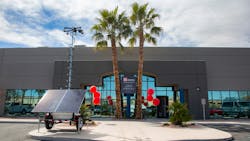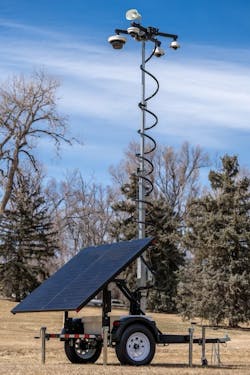This article originally appeared in the August 2023 issue of Security Business magazine. When sharing, don’t forget to mention Security Business magazine on LinkedIn and @SecBusinessMag on Twitter.
I began my career by joining the United States Army and spent most of my time in the service overseas, running combat missions. My training and experience taught me the Castle Approach, or as we refer to it in the military, defense-in-depth (DiD). I can attest from years of experience that it is extremely effective.
Defense-in-depth is a security strategy or approach involving multiple layers of defense mechanisms to protect systems and assets from potential threats. Today, it is a concept often employed in cybersecurity but can also be applied to physical security and other domains.
The main idea behind the defense-in-depth is to create multiple lines of protection so that if one layer is breached or fails, other layers are in place to mitigate the risk and prevent further compromise. Each layer typically comprises various security controls, measures, and technologies, collectively providing comprehensive protection.
By employing multiple layers of security controls and practices, defense-in-depth helps to deter potential threats, detect unauthorized activities, and delay or mitigate the impact of security incidents. It recognizes that more than relying on a single security measure can be required, and a layered approach provides a more robust and resilient security posture.
For security integrators, Mobile Security as a Service (MSaaS) has proven to be significantly effective at providing reliable defense-in-depth in a portable package. These units can be rapidly deployed anywhere in the world, and are ideal for construction environments, special events, parking lots, and other high-risk security locations. Accompanying monitoring services can provide integrators with a steady stream of RMR.
The Benefits of MSaaS for Customers
MSaaS, when done correctly, provides far more benefits than a traditional human guard service. It comes at a lower overall cost with better reliability and less risk.
Security integrators offering MSaaS solutions should provide full-service remote and onsite delivery, setup, and support on every MSaaS unit. This can be subcontracted; however it is important to notify the end-user who is coming onto a property.
It is also important that the hardware utilizes NDAA-approved products, especially for government and law enforcement applications.The benefits for customers include:
1. Self-sustained power and data, that can run on solar and/or fuel cells with shore power.
2. A redundant cellular smart modem finds and connects to the nearest tower, so it does not throttle a data plan; instead, it has a fixed cost and alerts to overages.
3. Real-time health monitoring of all devices ensures the entire system is constantly online and operational, and users always know where it is, and if it is being tampered with.
4. Deep Learning and object-based classification plus detection. MSaaS solutions “see” better than the human eye and never sleeps. Be sure to partner with experts to test and vet best-in-class open platform technology and use reliable solutions to detect what the end-user wants to catch, while limiting false alerts to events such as small animals or trees blowing in the wind. We know that false alarms cannot be tolerated, so we continuously invest countless hours in selecting only the best technologies.
5. Dynamic audio is a key component of deterrence. Potential bad actors know they are being seen and monitored by dynamically speaking to them over 130-decibel loudspeakers in real-time. We remote test and calibrate the speaker systems, ensuring 100% uptime and saving costs in deploying service engineers.
6. Dynamic lighting technology changes color and intensifies based on the time of day, object, or event. For example, when smart cameras see a crowd gathering, the lighting will dynamically change color, audio chimes/voice will be introduced, and alarms will be sent.
7. UL Listed central station monitoring, which includes video verification and live talk-down, are key to events where police must be dispatched. Security operators can communicate directly with law enforcement in real-time with eyes on the scene. This is also a key component of the recurring revenue aspect for integrators.
8. They are affordable: Hardware providers can offer both CapEx and OpEx mobile unit options, which can be customized to fit a particular customer’s needs and budget.
9. Bolt-on additional technologies and services, such as people counting, time-in-area analysis, and weapons detection can be easily added to a mobile security unit.
Additional Tips for Integrators
Integrators who choose to offer MSaaS solutions should choose and open platform solution, with reputable Soc 2 Type II certification.
Each unit should have an accompanying support agreement to ensure 100% uptime and effectiveness. To maximize the true benefits, it is imperative that your support team has an in-depth understanding of high-end analytics and know that, like anything, you must minimize false positives by testing and subsequently deploying only the best, most reliable hardware and software.
7 Key Components of Defense-in-Depth for Physical Security
In physical security, refers to implementing multiple security measures to protect physical assets, facilities, and personnel from potential threats. It is a concept that aims to provide comprehensive and resilient security by combining various security controls and practices.
Here are the seven key components to defense-in-depth:
1. Perimeter Security: The outermost layer of defense involves securing the perimeter of a facility. This may include physical barriers like fences, walls, gates, and access control systems to control and monitor entry and exit points.
2. Access Control: Once inside the perimeter, access control measures are implemented to restrict and manage access to different areas within the facility. This can include techniques such as ID badges, keycards, biometric systems, and security personnel to verify and grant access to authorized individuals only.
3. Surveillance Systems: Utilizing video surveillance cameras, alarms, and intrusion detection systems allows for constant facility monitoring. Surveillance systems can provide real-time information on potential threats or suspicious activities, enabling a quick response.
4. Security Personnel: Trained security personnel, such as guards or security officers, play a crucial role in physical security. They can patrol the premises, respond to incidents, and provide additional deterrence.
5. Security Policies and Procedures: Establishing clear security policies and procedures is essential to follow security measures consistently. This includes protocols for incident response, emergency evacuation, visitor management, and employee awareness training.
6. Physical barriers and Reinforcements: Beyond the perimeter, physical barriers can be implemented within the facility to enhance security. Examples include locked doors, security grilles, reinforced windows, safes, and secure storage areas for sensitive assets.
7. Redundancy and Backup Systems: Implementing redundancy and backup systems can help ensure continuity of operations in the event of a security breach or failure of certain security measures. This could involve backup power supplies, redundant communication systems, or duplicate critical infrastructure.
Each security measure needs to be revised. As security practitioners, we aim to create a multi-faceted defense strategy that can adapt to evolving threats. At Stone Security, we lean on evidence-based approaches like the “Zones of Influence” concept developed by the Loss Prevention Council (LPRC). The key takeaway is that being seen is extremely effective in deterring crime.
About the Author

Robert Oldham
Robert Oldham, CPP, PSP, PCI, is VP of Sales for Utah-based integrator Stone Security. He was a memeber of the U.S. Department of Defense and served in combat zones in the Middle East. He holds the Triple Crown of ASIS ceritifications and is also CPTED certified. Connect with him on LinkedIn: www.linkedin.com/in/robert-oldham.


